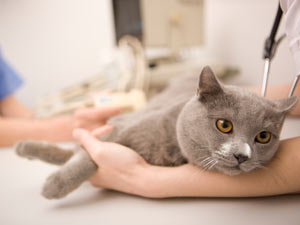Feline Leukemia Virus

There are many infections and parasites to which cats are susceptible. Among the most serious of these are the various feline viruses. Feline leukemia virus, or FeLV, is a common feline virus present in cat populations around the world. In fact, FeLV is associated with a higher degree if disease and death in cats than any other condition (Lowe).
How Is Feline Leukemia Virus Spread?
According to the Cornell Feline Health Center, about two to 3% of American cats are infected with FeLV. The leukemia virus is shed in the saliva and nose discharges of infected cats. The virus is relatively unstable and cannot live outside of an infected cat for more than a few hours in a dry environment. It is spread from cat to cat through shared food and water bowls and close contact like grooming. FeLV can be transmitted from a mother cat to her kittens in utero, through mother-kitten contact, or through her milk. Cat bites are another source of infection. Kittens are especially susceptible to contracting FeLV. After four months of age, natural resistance develops in many cats. Adults are relatively resistant to infection with FeLV.
What Happens If Cats Get Feline Leukemia?
When a cat first contracts FeLV, they are termed "viremic." This means that there is virus in the cat's bloodstream. The viremic stage may progress to:
- Persistent infection. Some cats, once infected, become actively infected within weeks of exposure. Virus is found in their blood and bone marrow. This is especially the case in young kittens exposed to FeLV.
-
Sequestered infection. Other cats will contract the virus and then sequester it (hold it inactively) in their bone marrow or other tissues for a variable length of time. Later, if the cat is stressed or treated with immune-suppressing medications, the leukemia virus can be released and cause active disease. These cats may also be able to spread the virus to other cats.
- No disease. There is a proportion of cats exposed to the virus that clear it from their system, leaving no trace of FeLV in their blood, bone marrow, or other tissues. These cats can develop immunity to FeLV. It turns out, after careful study, that many of these cats are really latent carriers of the infection, but some of these cats with deeply integrated, sequestered virus can live a healthy life without ever developing disease symptoms.
Cats with persistent FeLV infection may develop any of three major disease syndromes:
- Immune suppression. This occurs in most FeLV-infected cats. The virus attacks the cat's immune system and leaves the body susceptible to infection by many different agents. Systemic infections, diarrhea, skin infections, eye conditions, respiratory tract infections, bladder infections, and oral infections are all commonly seen in cats affected by FeLV. Any severe, chronic illness can be a sign of an underlying FeLV infection.
- Anemia. A low red blood cell count is common in cats with active feline leukemia infections. This may cause lethargy, decrease appetite, and weakness.
- Lymphoma or leukemia. These serious cancers can develop in cats secondarily to infection by the feline leukemia virus.
Diagnosis of Feline Leukemia Virus
Testing for FeLV is somewhat complex. It is important to remember that not all tests are 100% accurate under all conditions. Here are some important facts about FeLV tests as outlined by the American Association of Feline Practitioners (Richards, 2008).
- Most initial screening for FeLV is conducted using a simple blood test called the ELISA. Kittens may be ELISA-tested at any age, but the virus may not be detected until weeks to months after birth. A positive ELISA test indicates that there is FeLV virus in the cat's body.
- It can take up to three months after initial exposure for an ELISA test to be positive. For this reason, any at-risk cat or kitten, such as a new adoptee, should be retested for FeLV after three months have passed, regardless of an initial negative test result.
- FeLV vaccination does not interfere (also called cross-react) with subsequent FeLV testing. If a previously FeLV-vaccinated cat tests positive, true infection should be suspected.
- If a cat has a positive FeLV test by the ELISA method, then a second blood test called the IFA will be used to verify the results. This test indicates that there is feline leukemia virus replicating in the cat's bone marrow and circulating in the bloodstream.
- If the IFA test is positive, this means that the cat is persistently infected with feline leukemia virus. IFA-positive cats, as well as many ELISA-positive cats, shed virus in the saliva and are, therefore, infectious to other cats.
- Sometimes, "discordant" test results occur. For example, two sequential ELISA tests may disagree, or a cat may test ELISA-positive but IFA-negative. According to the American Association of Feline Practitioners, discordant tests may be a consequence of the stage of infection, the variability of host response, or technical problems with the testing system.
- Cats with discordant test results should be considered contagious to other cats.
- Your veterinarian is best able to walk you through the fine points of FeLV diagnostics and the implications for your individual cat.
Treatment of Feline Leukemia Virus
At this time, there is no cure for FeLV infection. Although some therapies may help alleviate clinical signs or in some cases produce temporary remission of infections, they are not permanent cures. The disease is usually eventually fatal. Sadly, 85% of cats with FeLV infection die within three years of the diagnosis.
Medications may allow the infected cat to continue life in a healthy state for weeks to months. Some veterinarians may prescribe certain antiviral drugs or immune system modulators normally intended for humans. These may provide some clinical improvement for a while. Never give any medication to your cat unless specifically prescribed by a veterinarian.
Advances are continually being made in the diagnosis and management of FeLV. For the latest information, it's always best to consult with your veterinarian.
How Can FeLV Infection Be Prevented?
Definitive information on the diagnosis and management of FeLV can be found on the American Association of Feline Practitioners (AAFP) website.
Although scientific research may eventually uncover a cure for this disease, preventing infection is the best way to protect your cat. The following measures are recommended:
- Vaccinate indoor-outdoor cats for FeLV if they contact other cats (especially strays).
- Test all new cats before they are brought home.
- In multi-cat households, periodically retest cats who may be at risk. This includes outdoor cats, escapees, cats with bite wounds, and recently adopted kittens.
- In multi-cat households, keep food, water, and litter pans as sanitary as possible.
Although FeLV vaccines are effective, it is important to remember that they do not give 100% protection against infection in all cats. At-risk kittens can be vaccinated at around nine weeks of age, with a booster given in three weeks, and then given at an interval dictated by the lifestyle and risk of exposure of the cat. Vaccination will not protect a cat that has already been infected with the virus.
Works Cited
- Lowe, A. (n.d.). Feline Leukemia Virus. Retrieved from catvets.com: How can the veterinarian diagnose this disease?
- Richards, D. J. (2008). 2008 AAFP Feline Retrovirus Management. Retrieved from catvets.com.
You May Also Like These Articles:
Alternative and Holistic Veterinary Medicine for Cats
Upper Respiratory Tract Conditions in Cats
Why Should I Take My Cat to the Vet?
Notice: Ask-a-Vet is an affiliated service for those who wish to speak with a veterinary professional about their pet's specific condition. Initially, a bot will ask questions to determine the general nature of your concern. Then, you will be transferred to a human. There is a charge for the service if you choose to connect to a veterinarian. Ask-a-Vet is not manned by the staff or owners of CatHealth.com, and the advice given should not delay or replace a visit to your veterinarian.






